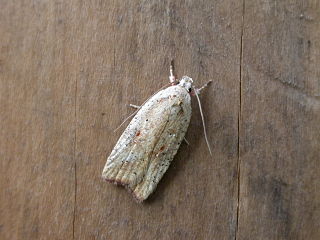Related Research Articles

The gorse tip moth is a smallish moth species of the family Depressariidae.

Depressaria is a moth genus of the superfamily Gelechioidea. It is the type genus of subfamily Depressariinae, which is often – particularly in older treatments – considered a distinct family Depressariidae or included in the Elachistidae, but actually seems to belong in the Oecophoridae.

Depressaria chaerophylli is a moth of the family Depressariidae.

Depressaria badiella is a moth of the family Depressariidae. It is found in most of Europe, Libya, the Caucasus and Mongolia.

The parsnip moth or parsnip webworm is a moth of the family Depressariidae. It is found in most of Europe, except Portugal and most of the Balkan Peninsula.
Agonopterix bipunctifera is a moth in the family Depressariidae. It was described by Shōnen Matsumura in 1931. It is found in the Japanese islands of Honshu and Hokkaido and on the Kuriles of Russia.
Agonopterix l-nigrum is a moth in the family Depressariidae. It was described by Shōnen Matsumura in 1931. It is found on the Japanese island of Hokkaido and the Amur and Primorsky regions of the Russian Far East.
Agonopterix takamukui is a moth in the family Depressariidae. It was described by Shōnen Matsumura in 1931. It is found in Japan (Kyushu) and the Russian Far East.
Depressaria angustati is a moth in the family Depressariidae. It was described by John Frederick Gates Clarke in 1941. It is found in North America, where it has been recorded from Washington.
Depressaria yakimae is a moth in the family Depressariidae. It was described by John Frederick Gates Clarke in 1941. It is found in North America, where it has been recorded from Washington.
Depressaria leptotaeniae is a moth in the family Depressariidae. It was described by John Frederick Gates Clarke in 1933. It is found in North America, where it has been recorded from Oregon, Alberta, Idaho and Washington.
Depressaria multifidae is a moth in the family Depressariidae. It was described by John Frederick Gates Clarke in 1933. It is found in North America, where it has been recorded from Oregon, Washington, Idaho and California.
Depressaria irregularis is a moth of the family Depressariidae. It is found in Japan and the Russian Far East.
Agonopterix taciturna is a moth in the family Depressariidae. It was described by Edward Meyrick in 1910. It is found in the Himalayas, the Russian Far East and Japan.
Depressaria petronoma is a moth in the family Depressariidae. It was described by Edward Meyrick in 1934. It is found in Japan.
Depressaria spectrocentra is a moth in the family Depressariidae. It was described by Edward Meyrick in 1935. It is found in Japan.
Depressaria djakonovi is a moth in the family Depressariidae. It was described by Alexandr L. Lvovsky in 1981. It is found in southern Siberia.
Depressaria filipjevi is a moth in the family Depressariidae. It was described by Alexandr L. Lvovsky in 1981. It is found in the Russian Far East (Amur).
Depressaria sibirella is a moth in the family Depressariidae. It was described by Alexandr L. Lvovsky in 1981. It is found in the Russian Far East.
Depressaria nomia is a moth in the family Depressariidae. It was described by Arthur Gardiner Butler in 1879. It is found in Japan.
References
- ↑ Depressaria at Markku Savela's Lepidoptera and Some Other Life Forms.
- ↑ "Oecophoridae collection of Siberian Zoological Museum". Archived from the original on 2016-02-17. Retrieved 2016-03-17.
- ↑ Japanese Moths